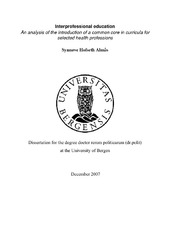| dc.description.abstract | The aim of the study: - to to identify cultural differences between various professions and educational institutions - to to explore how the implementation of the common core in curricula influenced students’ professional habitus (identities) - when taught separately - when taught interprofessionally with longer or shorter duration - to to identify whether, and if so how, differences in the dimensions of interprofessional education affect students’ perception of their own and of another health care profession’s cultural capital (competence) Context: The Norwegian government introduced a common core into the curricula (modified curricula) for all health and social educational programmes in the conviction that this would result in more collaboratively and thereby more effective and efficient health care. It called upon profession-oriented studies to introduce interprofessional education across the health and social disciplines with opportunities for interaction in the expectation that this would reinforce students’ perceptions of their interprofessionalism and their habitus as health workers. Theoretical framework: Bourdieu’s theory of the educational system was chosen to shed light on the implementation process of the common core and to interpret interprofessional education in health care. Methodological approach: A comparative, explorative design was chosen to study health care students’ perceptions of interprofessionalism and of their own and of other professions’ cultural capital. Different health care students at Oslo University College and Ålesund University College participated in ‘StudData’, a national database for studies of recruitment and qualifications in professions. The students were asked to respond to statements in a questionnaire about interprofessionalism. Students at Bergen University College and the Karolinska Institutet, Stockholm, with different duration and modes of interprofessional education were also selected in order to get an insight into the students’ socialisation process concerning interprofessional cultural capital. All data were analysed using SPSS; comprising cross-tables, one-way analysis of variance, while STATlab was applied to carry out correspondence analysis and analysis of hierarchical classification. Results: Part I Students’ perceptions of interprofessionalism Students from five professions valued interprofessionalism differently. The occupational therapy (OT) and nursing students were more positive towards interprofessional education and collaborative practice than were the radiography and medical laboratory science students. Nursing students from four educational institutions understood interprofessionalism differently, those at Bjerregaardsgt. and Ullevål being more positive than those at Aker and Ålesund. Students with a modified curriculum appreciated interprofessionalism more highly than did those with an unmodified curriculum (before the revising of the curricula). The results showed that students having the common core implemented as interprofessional education valued interprofessional studies and work more highly than those with the common core implemented as uniprofessional education. Students with longer interprofessional education appreciated interprofessional practice more highly than those with shorter interprofessional education. Part II Students’ perceptions of own and the other profession’s capability The mature OT and physiotherapy (PT) students at the Karolinska Institutet, with longer experience in health care before starting the study than corresponding students at Bergen University College had a broader view of their own and of other professions’ cultural capital. The younger OT and PT students at Bergen University College, with less experience in health care, expressed a narrower perception of an OT’s and a PT’s cultural capital. Discussion: The implementation process of the common core in the curricula and the results from empirical data of the student groups’ perceptions are discussed in relation to theory, biosocial variables (as part of students’ habitus), and result of previous research in the field. Finally, findings are seen in relation to how to improve students’ habitus as health workers and their interprofessional cultural capital. | en_US |
